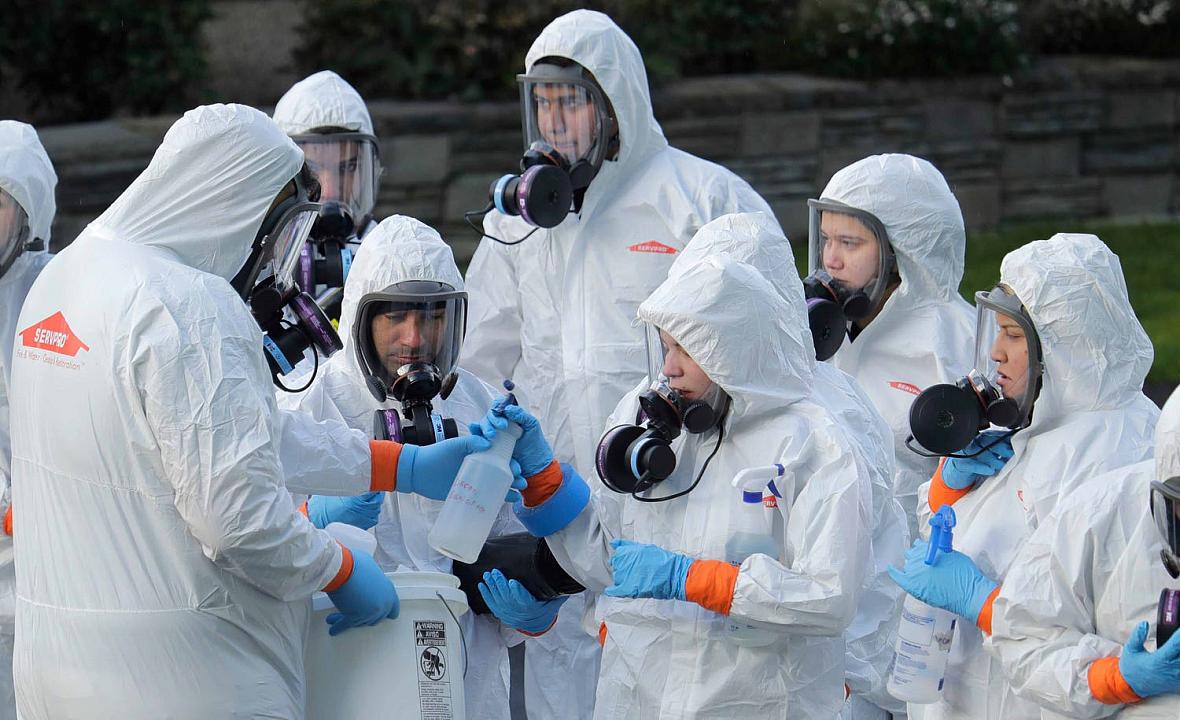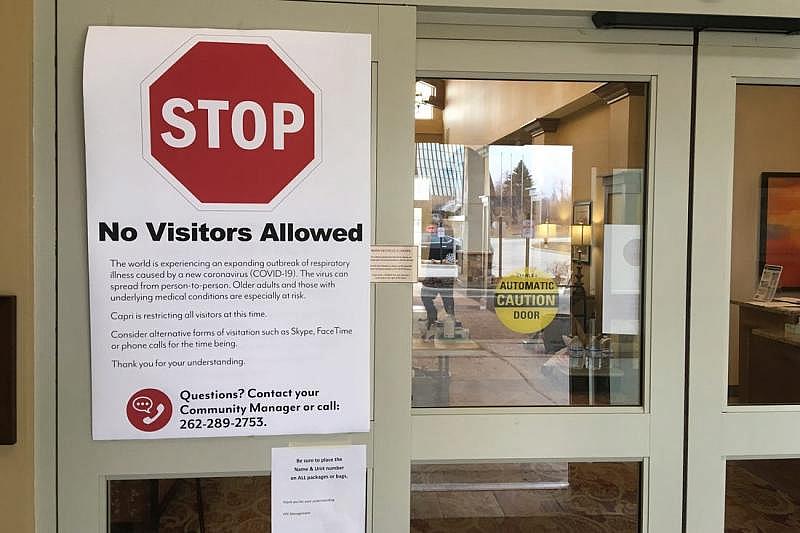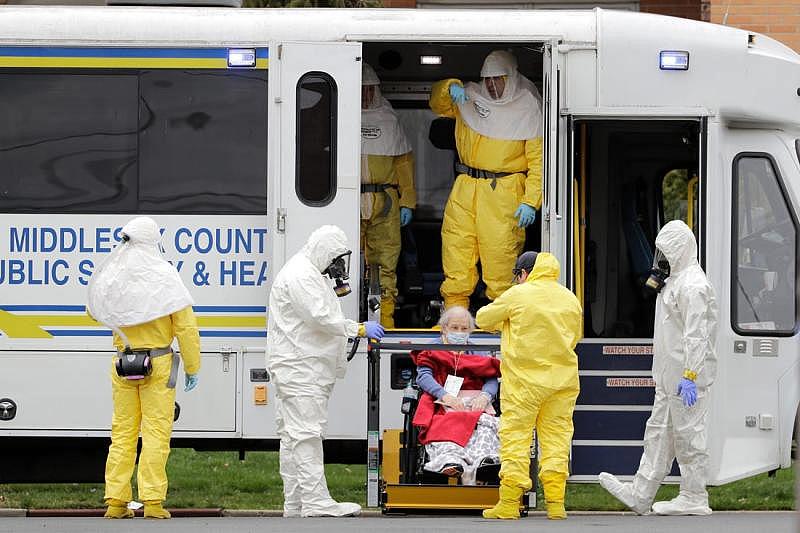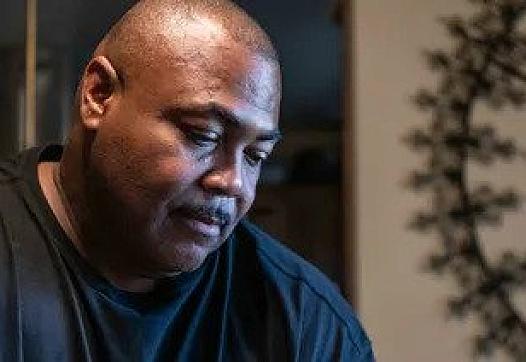When does a nursing home COVID-19 death count? It's complicated.
This story was originally published in USA Today with support from our 2021 National Fellowship.

Disaster recovery workers wore protective gear to enter the Life Care Center in Kirkland, Washington in March 2020 during the first major outbreak of COVID-19 in a U.S. nursing home.
TED S. WARREN, AP
By Nick Penzenstadler
The nation’s first major COVID-19 outbreak in a nursing home outside Seattle warned that authorities would need to closely monitor the pandemic’s impact on the medically vulnerable. But a seemingly simple question – how many nursing home residents have gotten sick and died – has often turned into a political minefield.
In the early days of the pandemic, there was no good answer. It was not until several months in that the federal government created a standard approach across the states for reporting cases and deaths into the National Healthcare Safety Network, operated by the Centers for Disease Control and Prevention.
For its first-of-its-kind analysis of nursing home ownership and COVID-19 performance, USA TODAY relied on this data. Information from it was updated by facilities and publicly shared each week by the Centers for Medicare and Medicaid Services, the federal government’s nursing home regulator, which required the facilities to accurately report their information.
The CDC has received waves of technical questions from nursing homes on judgment calls and specific scenarios for what to include and responded with guidance and online FAQs. Trilogy Health Services, featured by USA TODAY, says the guidance from state and federal regulators was confusing and that as a result they overcounted their COVID-19 deaths – numbers they now say they will seek to revise based on current guidelines.
Nursing homes are federally regulated because they receive federal funding and required to report into the CDC online system. Lower levels of care, such as assisted living facilities, often only have to report to states. The COVID-19 reporting rules were new and didn’t become standardized until May 2020.

Protocols called for nursing homes to limit and ultimately ban visitors for a period of time during the pandemic. Here a March 27, 2020 photo shows a no visitors allowed sign at Village Pointe Commons, a senior care facility in Grafton, Wisconsin. GRETCHEN EHLKE, AP; SETH WENIG, AP

As nursing homes became overwhelmed with COVID-19 patients, some sought to transfer residents to other facilities. Here, residents from St. Josephs' Senior Home in Woodbridge, New Jersey, are helped onto a bus on March 25, 2020. GRETCHEN EHLKE, AP; SETH WENIG, AP
NHSN defined COVID-19 death as: “residents who died from SARS-CoV-2 related complications and includes resident deaths in the facility AND in other locations such as an acute care facility, in which a resident with COVID-19 was transferred to receive treatment.” The definition goes further to explain that deaths should be counted if the resident has a positive COVID-19 viral test, had signs or symptoms of COVID-19, were on transmission-based precautions or who died from ongoing complications related to a previous COVID-19 infection.
A few key scenarios based on CDC and CMS guidance.
Hospital deaths
If a sick resident has lived at a nursing home for years, acquired a COVID-19 infection and is transferred via ambulance to a local hospital and dies days later, that death should be counted as a nursing home death in the NHSN data.
Discharged deaths
Residents from long-term care facilities that were discharged, and specifically were not expected to return to the facility, should be excluded from the nursing home’s NHSN data. That would be the case if a family chose to transfer a sick nursing home patient to a private home where they later died.
91 days after infection
CDC guidance set the benchmark for a COVID-19 infection at 90 days. If a resident had a COVID-19 infection, continued to show symptoms for weeks and then died from COVID-19 complications, they could be counted in NHSN data. If, however, they died on the 91st day without symptoms, they could be excluded. A death certificate might still list COVID-19 as a primary or contributing cause of death.
Unknown cause of death
In general, NHSN is viewed as a “surveillance” tool, instead of a “clinical” tool. That means policymakers use it as a snapshot in time to help understand trends in the moment. Patient records and death certificates have the final say on causes of death. However, if a facility has no reason to believe a resident has died of COVID-19, they may exclude it from their count. But if they later receive an autopsy result indicating a positive COVID-19 viral test, the data should be edited to include it.
Mixed campus could cause confusion
Nursing homes are required to report into NHSN. But some operators also offer assisted living services on the same campus or in the same building. Once a resident receives any skilled nursing care, even if they never change rooms, they should be considered a nursing home resident and, if they die of COVID-19, be reported into NHSN. These in-campus transfers are common when someone needs medical care rather than just assistance with daily living.
State counts look different
State nursing home COVID-19 death counts may not look the same as CDC’s NHSN system. That’s due to a few factors including different definitions, reporting requirements and quality checks performed by the CDC and CMS before making the data public. Some states, including California and Michigan, adopted the same definitions as the CDC, giving facilities the option for state officials to forward their data to the CDC instead of submitting twice. But if a facility accidentally did submit twice, the CDC says it had systems in place to make sure the direct report took precedence over the information forwarded by a state.
Counting COVID-19 deaths in nursing homes unfortunately became just as politically fraught as masking and vaccine guidance, said Priya Chidambaram is a senior policy analyst with the Kaiser Family Foundation, a nonprofit organization focused on health issues. For much of the pandemic, the foundation tracked and published data at the national and state levels, including deaths of assisted living residents not reported into the NHSN.
The pandemic also exacerbated all of the longstanding nursing home issues, such as concerns over infection control, staffing shortages and funding, Chidambaram said.
“The reason this shocking level of mortality is frustrating and devastating is these aren’t new issues and more could have been done to prevent them,” she said. “We should care about any population that has seen this level of death and suffering.”
Nick Penzenstadler is a reporter on the USA TODAY investigations team. Contact him at npenz@usatoday.com or @npenzenstadler, or on Signal at (720) 507-5273.


